Dental Emergencies With Braces

Braces are incredible devices that can help transform your teeth and reshape your jaws. However, they are not always fool-proof. Every so often, a patient will have a dental emergency. That may be a bad cavity that needs to be fixed, or a bracket or wire will break. There are only a few dental emergencies that can happen with braces. We can help you to know what to do when each of those emergencies happen!
Origins of Braces
Orthodontic treatments have been around for a long time-even as far back as the ancient Egyptians! Although their ways were archaic, people for centuries have been trying to fix crooked teeth and develop a prettier smile through orthodontic work. The ancient Greeks, Romans, and Etruscans were known to have practiced orthodontia, and interestingly, the Etruscans used to attach gold bands to women’s teeth to preserve the position of their teeth after death. Orthodontics saw a surge in progress during the 18th century thanks to Pierre Fauchard. Known as the “Father of Dentistry,” he invented an appliance called a bandeau, which was a horseshoe-shaped piece of metal with regularly spaced holes that fit around the teeth to correct the alignment. He would also use forceps to physically realign teeth into their correct positions and tie them to neighboring teeth until they healed.
Orthodontics in the United States exploded during the 19th century. J.S. Gunnell created a type of headgear that fashioned to the head and exerted a soft pull on teeth while Charles Goodyear invented vulcanized rubber which would eventually become one of the most commonly used appliances in orthodontics. But Edward Hartley Angle, the “Father of Modern Orthodontics,” took orthodontics to another level by identifying the true properties of malocclusion, or misalignment, and addressed them with his own set of orthodontic appliances in 1880. Until the 1970s, orthodontist would attach anchored brackets around each tooth with winding wires, but with the invention of dental adhesives, orthodontists could then stick the brackets to teeth surfaces. Stainless steel then replaced gold and silver as the most popular option for wires, due to its manipulability, and became the most cost-efficient option for braces.
Dental Emergencies and What To Do About Them
Braces have come a long way since their beginnings many centuries ago, but as braces have evolved, so have the problems that come with them. Although dental emergencies are few and far between when it comes to braces, there are some common issues that can be readily addressed and fixed if serious enough. The least serious issues that you can have with your braces is tooth tenderness and lip and cheek sores. As your teeth become accustomed to your braces, your teeth will most likely be sore for 2-4 days. Using headgear, rubber bands, and springs can add to this soreness, but that discomfort normally goes away in the same amount of time. Eating soft foods and taking an over the counter pain reliever can help dull the ache. Loose or broke bands and brackets are also another annoyance that sometimes occur with braces. Although not considered an emergency, they normally break due to patient’s eating prohibited foods or picking at their braces. Whenever this occurs, place a piece of wax on the spot of irritation and wait until your next orthodontic appointment, unless the broken bracket breaks on one of the upper or lower front four teeth, then call your orthodontist as soon as possible.
Protruding wires are not only bothersome, but can stab the inside of your lips and mouth if not fixed. Wires can come loose from eating sticky foods, like candy, or by picking at your braces. If this has occurred, try using a Q-tip or pencil eraser to push the wire in towards the teeth. To avoid accidental damage to the wire, make sure to not bite your nails or pens and pencils. In rare occasions, a piece of the appliance may break and be swallowed by the patient. Although alarming, keep calm and have someone look in your mouth to see if the appliance if visible. If confident that you can remove it, you may carefully attempt to do so. If you are unable to see the piece, are coughing excessively, or having difficulty breathing, that could be a sign that the piece could have been aspirated and you should contact your orthodontist immediately.
How To Protect Your Braces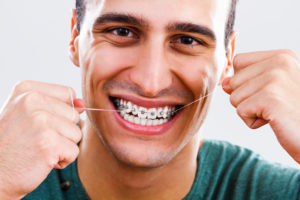
Unless under extenuating circumstances, most dental emergencies are avoidable. Maintaining good oral health and hygiene throughout your time with braces is vital in ensuring healthy teeth and gums, and preventing cavities. Food particles are easier to get stuck between braces, and when not cleaned thoroughly, can lead to other dental emergencies, like tooth decay, which can cause major complications. Hard foods, sticky foods, and foods high in sugar should be avoided as they are known to break brackets and cause cavities, which you more susceptible of developing while wearing braces. Some of the need-to-avoid foods include hard candy, nuts, apples, popcorn, ice, gum, caramel, and licorice.
Because braces are so notorious for getting food stuck in them, make sure that you are brushing after every meal to prevent staining and reducing bacteria buildup in your mouth. Use a soft brush, and brush each tooth by starting at the top and brushing down, then repeating the motion and brushing up around each bracket. Use threadable floss of a floss threader to get the hard to reach areas in between teeth that are covered by the archwire. Using the pointed end, insert between the teeth and gently move the floss back and forth between the two teeth. For added care, use a proxabrush, sometimes called a “Christmas tree brush,” to scrub between each bracket in an up and down motion to get any extra gunk that might be stuck there. For any dental emergencies that you might be having, make sure to contact Belmar Orthodontics at (303) 225-9016 for your next consultation!
Help for a Chipped, Cracked, or Broken Tooth with Braces

Your teeth are made up of 96% mineral content, making them the hardest substance in the body—even harder than the bones! However, that doesn’t mean that you won’t ever end up with a chipped, cracked or broken tooth. These are major dental emergencies that can cause you to permanently lose teeth if you don’t get dental attention right away. Find out what each of these emergencies are and what to do about them!
What Constitutes a Dental Emergency?
Each year, millions of people sustain mouth injuries that result in dental emergencies such as a cracked, knocked-out or broken tooth. At least 5 million cases of knocked out or broken teeth are reported each year, most of which happen during sports. Not enough athletes wear mouth guards for their teeth, which is why sports is one of the highest causes of dental emergencies.
Injuries to the mouth can be devastating not only to how a smile looks, but can be devastating to your gum tissue and teeth. A cracked, chipped, knocked-out or broken tooth can quickly result in dental infections or complete tooth loss in the affected area. Dental emergencies include toothaches (especially severe), severely chipped teeth, a chipped filling, broken crown or implant, a cracked tooth, knocked-out tooth or a broken tooth.
When it comes to braces, dental emergencies also include broken brackets or wires, pokey wires, a cut lip, cheek or gum and a loose or missing elastic tie. If a dental emergency happens with braces, it can severely cut up a patient’s gum tissue. That is why mouth guards are so important in sports if a patient has traditional metal braces, or lingual or ceramic braces.
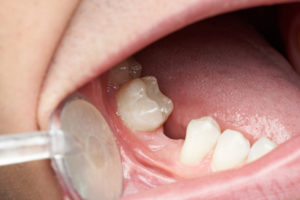
Chipped Teeth
A chipped tooth is only a dental emergency if the chip is large enough that it has displaced a filling or broken a dental appliance. If you have chipped a tooth or a filling but you feel no pain or tenderness after the chip has happened, it is probably not an emergency. However, when you can’t see the chip (because it was a filling), and there is tenderness, it is because a dental nerve is being exposed or dental decay was underneath the filling. You can fix a chipped tooth even with dental appliances such as brackets on your teeth.
How Serious Is a Cracked Tooth?
A cracked tooth is different than a chipped tooth, and much more serious even if you can’t see the crack. You can easily crack a tooth by eating the wrong foods depending on how hard your teeth are. Even though your teeth are very hard, the right amount of force can cause a cracked tooth. You can do this much easier if your eating habits (sugary foods and acidic/carbonated drinks) give you weaker tooth enamel. Patients are supposed to avoid hard foods with braces such as nuts, popcorn, hard carrots, apples, chips and similar foods. Poor oral hygiene or tooth decay during braces as well can lead to weaker teeth, meaning they may crack easier.
A cracked tooth actually is a serious dental emergency. A crack can continue to grow and can go all the way down to the tooth root. If you have a tiny line but no tenderness, it could just be an enamel crack. If you fracture a piece of your tooth off, it’s called a “fractured cusp”. This usually doesn’t cause much pain. Most cracked teeth fracture a tooth vertically towards the root, which leaves it open for quick infection. A root fracture is even more serious, as you will lose your tooth completely if you don’t get dental help asap.
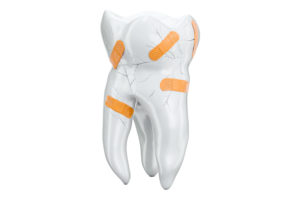
A Broken Tooth Is No Joke
A broken tooth can happen with or without braces on the tooth. If you have braces, you can end up with not only a broken tooth, but a cut gum or cheek if you’ve been hit in the face. The teeth can break off right at the gumline or can fracture a section off. Even if you break half of your tooth, your tooth root can be saved. If you have a dental emergency such as a knocked-out or broken tooth, get dental attention immediately. This is vital if you want to keep your natural tooth.
If you have brackets on your teeth at the time of the dental injury, make sure to call us right away. We may have to work with a dentist to remove your dental appliances so your restorative dentistry can be done. Right when a tooth break happens, save the part of the tooth that broke. Place it in a cup with water or milk and make sure to rinse your mouth well with warm water. Apply pressure with gauze or a cloth to the affected area. Couple this with a cold pack outside your mouth on the cheek to keep swelling down. Never handle your broken or knocked-out tooth more than you need to and never hold it by the tooth root. Call the dentist and orthodontist right away.
Avoid Dental Emergencies
Nobody wants to experience a dental emergency, especially if they have braces on their teeth. These can make dental emergencies so much worse. However, you can avoid a dental emergency with braces altogether. Wear mouth guards with every sport you play, even during practice. Take braces wax with you in a small pack so you can cover pokey wires or brackets. There are also tooth-saver kits that are small and can be carried with you if you ever have a knocked-out or broken tooth.
Eating hard foods should be avoided as well. Not only can you end up with a broken tooth or other dental emergency, but you can break a bracket or wire. If you have a dental emergency and wear braces, call Belmar Orthodontics at (303) 225-9016 to get the help you need!
Dental Emergencies with Braces
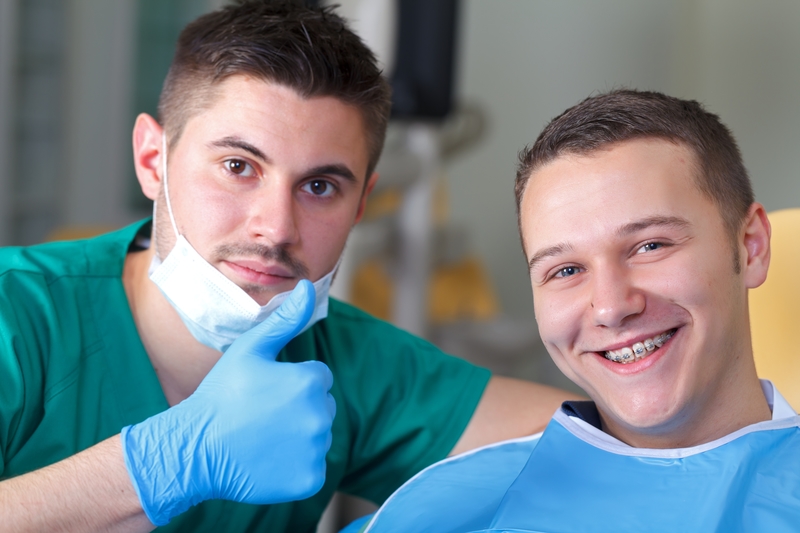
Getting braces on your teeth is an exciting time of life, as you are working towards a straighter, more beautiful smile. However, with hard work, there are often roadblocks along the way. Many patients find themselves with orthodontic or dental emergencies during their time with braces. Bands and brackets can become loose, wires can get pokey and problems with cavities or gum disease can happen. Find out what to do when orthodontic or dental emergencies like these strike and how to prevent them from happening in the first place!
What Dental Emergencies Are Common?
There are countless dental emergencies each year. Millions of people have them, and most don’t know what to do when they happen. Studies show that many people actually go to the emergency room for their dental emergencies instead of a dentist. However, those patients often get sent to their dentist or orthodontist anyways because they are the professionals that help with dental emergencies. If you ever have a dental emergency, call your dental or orthodontic office immediately to know what to do. If the problem is severe enough (such as a broken jaw), then go to the emergency room.
Dental emergencies that are common in patients include:
- Severe toothaches
- Cut or injury to the cheek, lip, tongue or gums
- A broken tooth
- A cracked tooth or tooth fracture
- Knocked-out permanent tooth
- Bleeding that doesn’t stop after a tooth falls out
If any of these dental emergencies happen to you, you want to promptly seek dental help. Some dental emergencies will have to be fixed by a dentist, while others will need the attention of an orthodontist. Luckily, orthodontic emergencies aren’t as severe as dental emergencies in most cases.
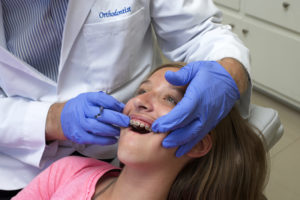
Dental Emergencies with Braces
You have to discern between dental emergencies and orthodontic emergencies. Problems with broken teeth are generally ones that a dentist will have to deal with. However, if you wear braces, then you will want to call both your dentist and your orthodontist. Some problems may need to be fixed without the bracket or wires on the teeth. For example, if a patient is having severe pain from a toothache, the problem could be tooth decay inside the tooth. A dentist can definitely fix the decay and fill the cavity, but the braces archwire or bracket might be in the way. In this situation, your orthodontist can take off your archwire—and even the bracket in certain instances—to fix the cavity.
If you break, crack, or fracture a tooth, you will need the orthodontist to remove your orthodontic appliance pieces in the area to receive your crown or dental implant. This is not something that happens often unless there is severe decay in a tooth that was fixed before braces. Most patients have a dental appointment before they get braces on their teeth to ensure there is no internal decay that will cause dental emergencies in the near future.
Types of Orthodontic Emergencies
Some orthodontic emergencies that can happen during your 18-24 months include:
- Tooth Tenderness: The first 2-4 days with braces can leave you with tender teeth. Use over-the-counter pain relievers to help with this pain and warm saltwater rinses, if needed. At every braces adjustment, you may notice soreness for the first 2-4 days that will fade. However, if your tooth tenderness doesn’t go away, seek orthodontic help, especially if the soreness turns into severe pain.
- Lip and Cheek Sores: Your mouth will have to adjust to braces. You will notice your braces a lot at first, but over time, the feel of them will become normal. The first few weeks is a common time for patients to get lip and cheek sores from brackets and wires. If you notice sores starting to form, use your orthodontic wax and place it on the area of your bracket or wire that is causing irritation. If that irritation persists, call us to adjust the orthodontic appliance.
- Pokey Wires: Wires can come loose from sticky foods or from picking at your braces. When a wire protrudes, it can cut your gums and the insides of your cheeks, causing them to bleed. At home, try using a Q-tip or clean pencil eraser to push the wire in towards the teeth. This should stop the problem, but also call our office to have the wire adjusted or cut so it doesn’t cut up the inside of your mouth.
- Loose Bands/Brackets: Brackets and bands can break, especially if you’re eating hard or sticky foods that are prohibited. In general, a broken bracket is not a dental emergency. However, if it causes you significant discomfort, call our office to have it fixed right away. This is especially true if the bracket or band hangs down or interferes with eating.
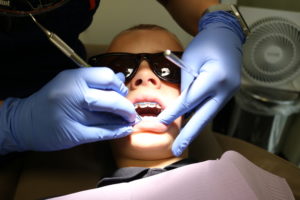
Seeking Help Promptly
Dental emergencies and orthodontic emergencies are never fun. However, there is a big difference between the two. Dental emergencies generally affect your overall oral health and can cause you to actually lose teeth if you don’t seek help. Anytime there is a broken, cracked, fractured, or knocked-out tooth, you want to seek prompt medical help. If you don’t, a dental implant might be your only option for restoring your smile.
Luckily, orthodontic emergencies aren’t quite as serious as dental emergencies. They can cause problems (even sores and cuts) with your teeth and gums, but you generally won’t lose a tooth in those situations. Your time with braces should be a pleasant, comfortable one. If your braces bother you or are painful, always let us know. For questions about orthodontic and dental emergencies, call Belmar Orthodontics today at (303) 225-9016!

